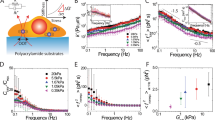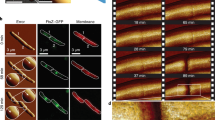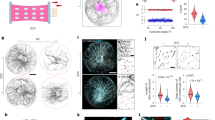Abstract
The life and death of an organism rely on correct cell division, which occurs through the process of mitosis. Although the biochemical signalling and morphogenetic processes during mitosis are well understood, the importance of mechanical forces and material properties is only just starting to be discovered. Recent studies have revealed that the layer of proteins beneath the cell membrane—the so-called cell cortex—stiffens during mitosis, but it is as yet unclear whether mechanical changes occur in the rest of the material in the cell, contained in the cytoplasm. Here we show that, in contrast to the cortical stiffening, the interior of the cell undergoes a softening and an increase in dissipative timescale, similar to viscoelastic relaxation. These mechanical changes are accompanied by a decrease in the active forces that drive particle mobility. Using optical tweezers to perform microrheology measurements, we capture the complex active and passive material states of the cytoplasm using six relevant parameters, of which only two vary considerably during mitosis. We demonstrate a role switch between microtubules and actin that could contribute to the observed softening.
This is a preview of subscription content, access via your institution
Access options
Access Nature and 54 other Nature Portfolio journals
Get Nature+, our best-value online-access subscription
$29.99 / 30 days
cancel any time
Subscribe to this journal
Receive 12 print issues and online access
$209.00 per year
only $17.42 per issue
Buy this article
- Purchase on Springer Link
- Instant access to full article PDF
Prices may be subject to local taxes which are calculated during checkout




Similar content being viewed by others
Data availability
Source data are provided with this paper.
Code availability
Python code used for analysing active microrheological and fluctuation analysis data is available at https://github.com/shmuen/Active_passive_microrheology.
References
Moulding, D. A. et al. Excess F-actin mechanically impedes mitosis leading to cytokinesis failure in X-linked neutropenia by exceeding Aurora B kinase error correction capacity. Blood 120, 3803–3811 (2012).
Levine, M. S. & Holland, A. J. The impact of mitotic errors on cell proliferation and tumorigenesis. Genes Dev. 32, 620–638 (2018).
Strangeways, T. S. P. Observations on the changes seen in living cells during growth and division. Proc. R. Soc. Lond. B 94, 137–141 (1922).
Lancaster, O. M. et al. Mitotic rounding alters cell geometry to ensure efficient bipolar spindle formation. Dev. Cell 25, 270–283 (2013).
Cadart, C., Zlotek-Zlotkiewicz, E., Le Berre, M., Piel, M. & Matthews, H. K. Exploring the function of cell shape and size during mitosis. Dev. Cell 29, 159–169 (2014).
Zlotek-Zlotkiewicz, E., Monnier, S., Cappello, G., Le Berre, M. & Piel, M. Optical volume and mass measurements show that mammalian cells swell during mitosis. J. Cell Biol. 211, 765–774 (2015).
Champion, L., Linder, M. I. & Kutay, U. Cellular reorganization during mitotic entry. Trends. Cell Biol. 27, 26–41 (2017).
Niethammer, P. et al. Discrete states of a protein interaction network govern interphase and mitotic microtubule dynamics. PLoS Biol. 5, e29 (2007).
Mchedlishvili, N., Matthews, H. K., Corrigan, A. & Baum, B. Two-step interphase microtubule disassembly aids spindle morphogenesis. BMC Biol. 16, 14 (2018).
Taubenberger, A. V., Baum, B. & Matthews, H. K. The mechanics of mitotic cell rounding. Front. Cell Dev. Biol. 8, 687 (2020).
Stewart, M. P. et al. Hydrostatic pressure and the actomyosin cortex drive mitotic cell rounding. Nature 469, 226–230 (2011).
Fischer-Friedrich, E. et al. Rheology of the active cell cortex in mitosis. Biophys. J. 111, 589–600 (2016).
Sorce, B. et al. Mitotic cells contract actomyosin cortex and generate pressure to round against or escape epithelial confinement. Nat. Commun. 6, 8872 (2015).
Cattin, C. J. et al. Mechanical control of mitotic progression in single animal cells. Proc. Natl Acad. Sci. USA 112, 11258–11263 (2015).
Nicklas, R. B. Measurements of the force produced by the mitotic spindle in anaphase. J. Cell Biol. 97, 542–548 (1983).
Brugués, J. & Needleman, D. Physical basis of spindle self-organization. Proc. Natl Acad. Sci. USA 111, 18496–18500 (2014).
Garzon-Coral, C., Fantana, H. A. & Howard, J. A force-generating machinery maintains the spindle at the cell center during mitosis. Science 352, 1124–1127 (2016).
Grill, S. W. & Hyman, A. A. Spindle positioning by cortical pulling forces. Dev. Cell 8, 461–465 (2005).
Pavin, N. & Tolić, I. M. Mechanobiology of the mitotic spindle. Dev. Cell 56, 192–201 (2021).
Oriola, D., Needleman, D. J. & Brugués, J. The physics of the metaphase spindle. Annu. Rev. Biophys. 47, 655–673 (2018).
Nazockdast, E. & Redemann, S. Mechanics of the spindle apparatus. Semin. Cell Dev. Biol. 107, 91–102 (2020).
Moore, A. S. et al. Actin cables and comet tails organize mitochondrial networks in mitosis. Nature 591, 659–664 (2021).
Mizuno, D., Tardin, C., Schmidt, C. F. & MacKintosh, F. C. Nonequilibrium mechanics of active cytoskeletal networks. Science 315, 370–373 (2007).
Stamenović, D. et al. Rheological behavior of living cells is timescale-dependent. Biophys. J. 93, L39–L41 (2007).
Ahmed, W. W. et al. Active mechanics reveal molecular-scale force kinetics in living oocytes. Biophys. J. 114, 1667–1679 (2018).
Bonfanti, A., Kaplan, J. L., Charras, G. & Kabla, A. Fractional viscoelastic models for power-law materials. Soft Matter 16, 6002–6020 (2020).
Yamada, S., Wirtz, D. & Kuo, S. C. Mechanics of living cells measured by laser tracking microrheology. Biophys. J. 78, 1736–1747 (2000).
Kollmannsberger, P. & Fabry, B. Linear and nonlinear rheology of living cells. Annu. Rev. Mater. Res. 41, 75–97 (2011).
Fabry, B. et al. Time scale and other invariants of integrative mechanical behavior in living cells. Phys. Rev. E 68, 041914 (2003).
Trepat, X., Lenormand, G. & Fredberg, J. J. Universality in cell mechanics. Soft Matter 4, 1750–1759 (2008).
Hoffman, B. D. & Crocker, J. C. Cell mechanics: dissecting the physical responses of cells to force. Annu. Rev. Biomed. Eng. 11, 259–288 (2009).
Desprat, N., Richert, A., Simeon, J. & Asnacios, A. Creep function of a single living cell. Biophys. J. 88, 2224–2233 (2005).
Deng, L. et al. Fast and slow dynamics of the cytoskeleton. Nat. Mater. 5, 636–640 (2006).
Rigato, A., Miyagi, A., Scheuring, S. & Rico, F. High-frequency microrheology reveals cytoskeleton dynamics in living cells. Nat. Phys. 13, 771–775 (2017).
Nishizawa, K. et al. Feedback-tracking microrheology in living cells. Sci. Adv. 3, e1700318 (2017).
Mezger, T. G. The Rheology Handbook 4th edn (Vincentz Network, 2012).
Moeendarbary, E. et al. The cytoplasm of living cells behaves as a poroelastic material. Nat. Mater. 12, 253–261 (2013).
MacKintosh, F. C. & Levine, A. J. Nonequilibrium mechanics and dynamics of motor-activated gels. Phys. Rev. Lett. 100, 018104 (2008).
Krall, A. H. & Weitz, D. A. Internal dynamics and elasticity of fractal colloidal gels. Phys. Rev. Lett. 80, 778–781 (1998).
Guo, M. et al. Probing the stochastic, motor-driven properties of the cytoplasm using force spectrum microscopy. Cell 158, 822–832 (2014).
Turlier, H. et al. Equilibrium physics breakdown reveals the active nature of red blood cell flickering. Nat. Phys. 12, 513–519 (2016).
Xie, J. & Minc, N. Cytoskeleton force exertion in bulk cytoplasm. Front. Cell Dev. Biol. 8, 69 (2020).
Mayer, M., Depken, M., Bois, J. S., Jülicher, F. & Grill, S. W. Anisotropies in cortical tension reveal the physical basis of polarizing cortical flows. Nature 467, 617–621 (2010).
Shamipour, S. et al. Bulk actin dynamics drive phase segregation in zebrafish oocytes. Cell 177, 1463–1479 (2019).
Skoufias, D. A. et al. S-trityl-l-cysteine is a reversible, tight binding inhibitor of the human kinesin Eg5 that specifically blocks mitotic progression. J. Biol. Chem. 281, 17559–17569 (2006).
Mason, T. G. & Weitz, D. A. Optical measurements of frequency-dependent linear viscoelastic moduli of complex fluids. Phys. Rev. Lett. 74, 1250–1253 (1995).
Nguyen, A., Brandt, M., Muenker, T. M. & Betz, T. Multi-oscillation microrheology via acoustic force spectroscopy enables frequency-dependent measurements on endothelial cells at high-throughput. Lab Chip 21, 1929–1947 (2021).
Sollich, P., Lequeux, F., Hébraud, P. & Cates, M. E. Rheology of soft glassy materials. Phys. Rev. Lett. 78, 2020–2023 (1997).
Caputo, M. Linear models of dissipation whose Q is almost frequency independent—II. Geophys. J. Int. 13, 529–539 (1967).
Acknowledgements
We thank T. Münker for technical support and helpful discussions. We are thankful for critical comments by E. Raz and M. Reichman-Fried. We thank R. Wedlich-Söldner for the MDCK II cell line expressing H2B-mCherry and GFP-LifeAct and the HeLa line expressing H2B-mCherry, and we thank A. Sivan for his help generating patterns. We thank C. Brennecka for critical revision of the manuscript. S.H., M.B. and T.B. were supported by the Interdisciplinary Center for Clinical Research (IZKF) Münster (Bet1/013/17). T.B. was supported by the European Research Council ERC-Consolidator grant PolarizeMe (771201) and by the DFG under Germany’s Excellence Strategy (EXC 2067/1- 390729940).
Author information
Authors and Affiliations
Contributions
S.H. designed the study, carried out experiments and analysed data. B.E.V. and M.B. contributed to the experiments and provided helpful discussions. T.B. analysed data and designed and supervised the study. All authors wrote the manuscript.
Corresponding author
Ethics declarations
Competing interests
The authors declare no competing interests.
Additional information
Peer review information Nature Physics thanks Dimitrije Stamenovic and the other, anonymous, reviewer(s) for their contribution to the peer review of this work.
Publisher’s note Springer Nature remains neutral with regard to jurisdictional claims in published maps and institutional affiliations.
Extended data
Extended Data Fig. 2 Intracellular viscoelasticity and activity in dividing HeLa cells.
The parameters show a similar behaviour of mechanical properties as in MDCK cells. a) Power-law exponents α and β of viscoelastic fit for different phases of mitosis. b) Prefactor cα of viscoelastic fit. c) Prefactor cβ of viscoelastic fit. d) Prefactor e0 of power-law fit to active energy. e) Power-law exponent ν of fit to active energy. ncells: 20, 11, 23, 11, 10.
Extended Data Fig. 3 Intracellular viscoelasticity and activity dependence on cell shape.
Interphase cells forced into a round shape comparable to dividing cells show increased stiffness. a) Fluorescent images of interphase cell forced into a round shape (left), cell in metaphase (middle) and cell arrested in mitosis by STC (right). Red: H2B; cyan: actin. b) Prefactors cα, cβ and e0. cα shows drastic increase of stiffness in interphase cells forced into a round shape. c) Exponents α, β and ν. Only ν shows a significant increase, which is not seen in mitotic cells. d) Fold changes of all parameters of cells forced into a round shape compared to flat interphase cells. Error bars indicate normalized error. The found differences cannot explain the changes found in mitotic cells. In round interphase cells stiffness increases, while stiffness drastically decreases in mitotic cells. ncells: 57, 63.
Extended Data Fig. 4 Comparison of passive and active mechanical parameters of MDCK cells in prophase and arrested in mitosis by STC.
The parameters do not show a significant difference between cells in prophase and cells treated with STC, which arrests the cells in mitosis. ncells: 15, 36. Data shows mean ± SE.
Extended Data Fig. 5 Comparison of material property parameters in mitotic cells after treatment with different actin drugs.
Treatment with cytochalasin B (20.9 μM), cytochalasin D (10 μM) and latrunculin A (474 nM) all lead to similar parameters. ncells: 55, 58, 47.
Extended Data Fig. 6 Radial intensity of actin and microtubules around particles.
Top: Immunostained cells in interphase and treated with STC; blue: nucleus, Hoechst; red: microtubules, anti-α-tubulin; cyan: actin, phalloidin; magenta: 1 μm particle, covalently bound dye. The yellow circle indicates the area around the particle that was analysed. Bottom: mean radial intensity of particle, actin and microtubule signal of 21 particles in interphase cells (left) and 10 particles in STC treated cells (right). Error indicates SD.
Supplementary information
Supplementary Table 1.
Parameters of fractional viscoelastic fits to MDCK and HeLa cells.
Source data
Source Data Fig. 1
Statistical source data for Fig. 1.
Source Data Fig. 2
Statistical source data for Fig. 2.
Source Data Fig. 3
Statistical source data for Fig. 3.
Source Data Extended Data Fig. 2
Statistical source data for Extended Data Fig. 2.
Source Data Extended Data Fig. 3
Statistical source data for Extended Data Fig. 3
Source Data Extended Data Fig. 4
Statistical source data for Extended Data Fig. 4.
Source Data Extended Data Fig. 5
Statistical source data for Extended Data Fig. 5.
Source Data Extended Data Fig. 6
Statistical source data for Extended Data Fig. 6.
Rights and permissions
About this article
Cite this article
Hurst, S., Vos, B.E., Brandt, M. et al. Intracellular softening and increased viscoelastic fluidity during division. Nat. Phys. 17, 1270–1276 (2021). https://doi.org/10.1038/s41567-021-01368-z
Received:
Accepted:
Published:
Issue Date:
DOI: https://doi.org/10.1038/s41567-021-01368-z
This article is cited by
-
Mechanical state transitions in the regulation of tissue form and function
Nature Reviews Molecular Cell Biology (2024)



